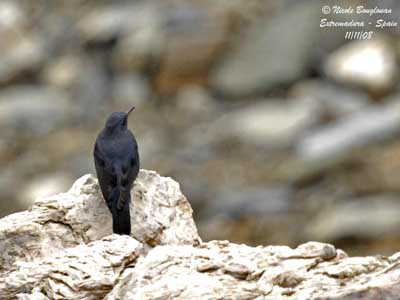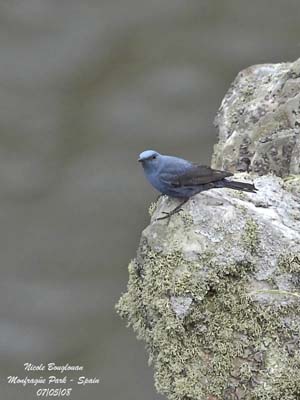
Blue Rock Thrush
Monticola solitarius
Passeriforme Order – Muscicapidae Family
BIOMETRICS: L : 20-23cm ; Weight : 50-70g.
DESCRIPTION:
The Blue Rock Thrush is an usual inhabitant of cliffs and rocky slopes where it nests.
The adult male in summer has deep blue plumage overall, darker and browner on wings and tail.
Tail feathers are black with slate-blue edges on outer rectrices.
On the wings, the flight feathers are blackish with slate-blue edges, more or less extended.
The head is blue with blackish lores. The slender black bill is relatively long. The eyes are dark brown. Legs and feet are greyish-black to black.
The adult male in winter plumage shows duller plumage with grey to sandy-buff edged feathers. Wings and tail are darker, but with paler tips and edges.

The adult female is duller, often brownish above. The underparts are streaked buff and brown from cheeks to breast. The lower breast, belly and vent are pale buff barred with brown.
Flight feathers and tail are slightly darker in summer, and with pale buff tips in winter plumage.
The juvenile resembles female but with more spots and scales than in female.
The Blue Rock Thrush has five subspecies spread in the distribution:
M.s. solitarius is the largest.
M.s. longirostris is slightly smaller. Male is duller and female is paler.
M.s. pandoo is smaller and darker than previous, with bluer male and more scaled underparts in female.
M.s. philippensis male is blue above, with chestnut underparts except throat and upper breast which are blue. Female is darker than other females.
M.s. madoci is the smallest. Female is more tinged blue than other females.
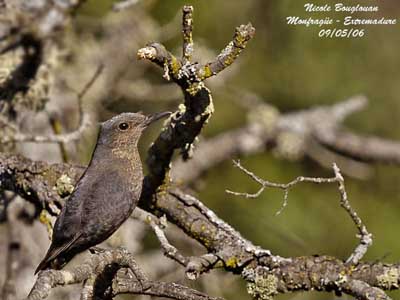
VOICE: SOUNDS BY XENO-CANTO
The Blue Rock Thrush often sings from a perch, but also in flight. It is a melodious song, composed with series of varied phrases, interspersed with brief pauses. Each phrase includes soft whistles, short whirring and trills. It may imitate some other birds’ songs.
Male and female utter songs, but the male sings more than female. The alarm call is a deep “tak-tak”, and we can hear a high “piiii” when threatened. These two sounds are combined in high alarm.
HABITAT:
The Blue Rock Thrush breeds in mountainous areas where there are cliffs, rocky valleys, rocky coastlines, and also in large ruined structures, quarries and monuments. It also may be found in urban areas in some parts of the range.
According to the country where it lives, this species occurs from sea level to 2700 metres of elevation, sometimes higher, up to 4000 metres in the Himalayas.
RANGE:
The Blue Rock Thrush occurs and breeds in southern Europe and north western Africa, and from Central Asia to northern China and Malaysia, Japan and Sumatra.
It winters within the breeding range, but also in northern Africa and Arabia.
The Asian species are migratory and winter in Africa, south of the Sahara, India and South-eastern Asia.
The other birds from Europe, northern Africa and Southern Asia are sedentary.
BEHAVIOUR:
The Blue Rock Thrush feeds on numerous and varied food items, from invertebrates and small vertebrates, to fruits. It forages by watching from a low perch, and drops to the ground when the prey is detected for catching it. It also hops and runs on the ground. It may sometimes perform flycatching and brief aerial sallies for insects. It also consumes fruits, taken from the plant or on the ground.
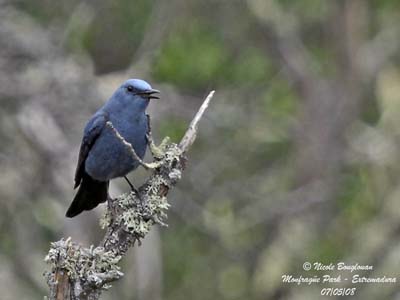
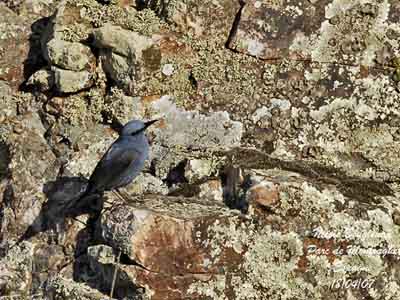
The Blue Rock Thrush is sedentary to partially migratory according to the range. When migrating, it flies by night, alone or in small groups of 3 to 4 birds.
The European species are sedentary, but they may perform some altitudinal movements in winter to lower areas.
The Blue Rock Thrush is territorial all year round if sedentary. The maintenance of the area is made by song from a perch. It is often seen sitting erect on prominent place, watching for insects.
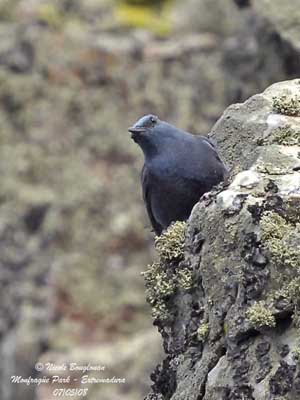
FLIGHT:
The Blue Rock Thrush flies low over its territory with shallow wing beats. It may perform rapid “escape-flight” if a predator or an intruder threatens it.
REPRODUCTION:
The breeding season varies according to the geographic range.
The Blue Rock Thrush nests in cliffs and rocky areas, in crevices, ledges under overhanging rocks, caves, buildings, and occasionally tree holes.
The nest is usually placed at about 2 to 5 metres above the ground, but sometimes very high in the face cliff. This nest may be reused year after year.
The nest is usually cup-shaped, loosely built with rootlets, dry grass, plant stems, bark and moss. The interior is lined with softer materials such as grasses, feathers or down, sometimes animal hairs too.
Female lays 4 to 5 pale blue to bluish-green eggs, finely marked with darker spots. Incubation lasts about 14 to 16 days, mainly by female. The young are fed by both parents and remain at nest during two weeks. They are able to fly at about three weeks of age, and both adults feed them for 15 days more after leaving the nest.
This species often produces two broods per season. The northern birds only have one, whereas the southern species may produce two or three broods per year.
DIET:
During the nesting period, the Blue Rock Thrush feeds the young with invertebrates, but also with soft-bodied items such as small lizards which are abundant in rocky areas.
This bird also feeds on varied insects, grasshoppers, beetles and flies, but also spiders, snails and earthworms, and some vertebrates such as lizards, frogs and even mice. In autumn and winter, it consumes fruits, berries and seeds.
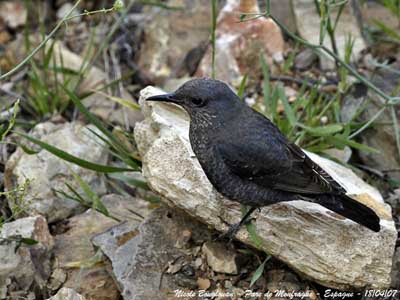
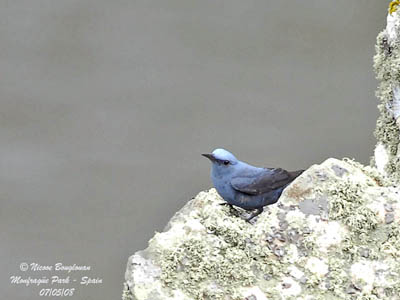
PROTECTION / THREATS / STATUS:
The Blue Rock Thrush is not globally threatened at this moment, and the populations seem to be stable. But some declines occurred due to coastal tourism increase, flooding of valleys for reservoirs, renovation of old ruined monuments and changes in the habitat.
Fr: Monticole bleu
All : Blaumerle
Esp : Roquero Solitario
Ital : Passero solitario
Nd : Blauwe Rotslijster
Russe : Синий каменный дрозд
Sd : Blåtrast
Text and photographs by Nicole Bouglouan
Sources:
HANDBOOK OF THE BIRDS OF THE WORLD Vol 10 by Josep del Hoyo-Andrew Elliott-David Christie - Lynx Edicions - ISBN: 8487334725
THRUSHES by Peter Clement and Ren Hathway – HELM - ISBN: 0713639407
Pájaros de España (JL Beamonte)
Wikipedia (Wikipedia, The Free Encyclopedia)
